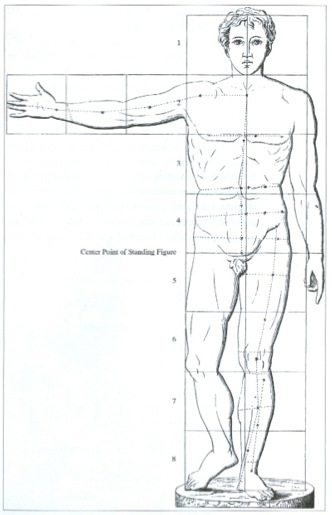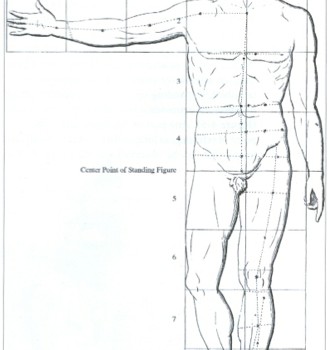 As you begin your exploration of the human figure, it is helpful to have information that furthers your understanding of basic proportional relationships.
As you begin your exploration of the human figure, it is helpful to have information that furthers your understanding of basic proportional relationships.
While the idealized canon of proportions tells us that a standing adult figure is 8 head-lengths tall, reality and experience tells us that many figures are closer to 7 ½ heads tall, and some are closer to 7 heads tall. This information is only applicable when dealing with the standing figure.
Careful observation and utilization of the sighting process is most important in establishing actual proportions, whether the figure is standing, seated, reclining, crouching, or in any number of other positions.
When using the head as a unit of measure, you can make some general proportional observations about a standing adult figure, whether male or female.
Beginning with the head length and repeating that length down the body toward the feet, you can anticipate some figurative landmarks that the head lengths will come close to if the standing adult is 7 to 7 ½ head lengths tall.
The first head length is determined by measuring from the crown to chin (take into account the axis of the head if it is tipped).
The second head length will bring you near the nipples of the breast (there is considerable variation here in women based on breast size).
The third head length will bring you to the region of the navel (will also correspond to the position of the elbows with the arms hanging at the sides).
The fourth head length brings you slightly below the actual midpoint of the body (located at the pubic bone in the male and slightly above the pubic bone in the female form).
The fifth head length will bring you to about the middle of the thigh.
** The sixth head length will bring you to below the knee (above the middle of the lower leg).
** The seventh head length will bring will bring you to just above the ankle.
** NOTE: These two measurements will vary depending upon whether or not the standing figure is 7 or 7 ½ head lengths high.
Some general information regarding comparative differences in proportion between the female and male form follows. (Differences are most evident when figures are standing, and pertain to adult figures who have reached their full height):
- Torso longer (from shoulders to hips) in relation to total body length because of the greater distance between the rib cage and the pelvis.
- Lower limbs (legs) shorter in relation to total body length.
- Neck longer in relation to head height.
- Shoulders narrower than male shoulders.
- Pelvis or hips broader than male pelvis or hips.
- Hips deeper from front to back than male hips.
- Hips shorter from top to bottom than male hips.
- Pelvis tipped farther forward, creating a stronger curve in the lower back.
- Hips typically the broadest part of the body, wider than shoulders.
- Arms shorter in relation to total body length because of shorter humerus.
- Elbows positioned higher in relation to torso.
- Hands positioned higher in relation to upper legs or thighs.
MALE:
- Torso shorter (from shoulders to hips) in relation to total body length because of the smaller distance between rib cage and pelvis.
- Lower limbs 9legs0 longer in relation to total body length.
- Neck shorter in relation to head height.
- Shoulders broader than female shoulders.
- Pelvis or hips narrower than female pelvis or hips.
- Hips shallower from front to back than female hips.
- Hips longer from top to bottom than female hips.
- Pelvis more upright, diminishing the curve in the lower back.
- Shoulders typically the broadest part of the body, wider than hips.
- Arms longer in relation to total body length because of longer humerus.
- Elbows positioned lower in relation to torso.
- Hands positioned lower in relation to upper legs or thighs.


